- Does your baby absolutely not want to look at the letters in the alphabet?
- Is your child about to start first grade, but can he be forced to read only under pain of being “excommunicated” from the computer?
- Don’t know how to organize classes with a preschooler in such a way as to save your nerves and not completely discourage his interest in reading?
These and other problems in teaching preschoolers to read can be solved by organizing classes in a playful way.
For preschool children, play is the leading form of activity. Therefore, engaging with a preschooler by playing different games is the easiest and most effective way to teach him to read. Before we talk about what games are best to play with your child when learning to read, we will give some general tips on organizing classes.
- Exercise regularly! Let the classes be short (5-10 minutes), but daily. This is much more effective for preschoolers than 45-minute lessons once a week.
- Exercise everywhere. To learn to read, you don't necessarily have to sit your child at a table with books. You can learn letters in the park while taking a walk, drawing them with chalk on the asphalt or looking at signs, helping mom make cookies in the shape of letters, or studying license plates of cars in the parking lot, etc.
- Exercise when your child feels well: he has slept, is active and is ready for new games and activities.
- Constantly create situations of success for your child, praise him more often, focus his attention on what he has accomplished, and do not dwell on failures. Classes should be a joy for the child!
And one more thing you definitely need to know when starting to learn to read is in the article at the link.
What games can be played at different stages of teaching preschoolers to read?
How to understand when it's time
To the question “When is it time for a child to learn to read?” There is no ready answer, but we would like to immediately warn against two misconceptions:
- “You don’t have to teach your child to read at home; they will teach you at school anyway.” Alas, they won’t teach - school teachers simply don’t have time to teach every child to read correctly. Already in the first lessons you will have to read books, textbooks, and inscriptions on the board. Not being able to read, a first-grader risks immediately falling behind his classmates and losing interest in learning.
- “There is no time to waste - the sooner the baby starts reading, the better.” All children are different and develop at their own pace. Therefore, you should not impose learning to read on a preschooler as soon as he is 4–5 years old, if the student himself does not yet show interest in this activity.
The indicator that you should focus on is not the age of the preschooler, but his speech skills.
It's time to learn to read if...
If a preschooler has already developed a sufficient vocabulary to chat with adults, if he constructs sentences grammatically correctly, understands and uses phraseological units in his speech, then the child is ready to learn to read.
Without a sufficient grammatical foundation and vocabulary, learning to read will be difficult. It is critical that the child understands the meaning of the words and phrases he reads, otherwise learning will not be productive. Therefore, if the child is not yet very confident in speaking, do not rush him into reading - this will not help develop speech, but will only demotivate him.
Objects and words
It is very important for a child to understand the difference between words and the real objects that represent them. “ONION” is a word, and it doesn’t sting your eyes, but it’s better to stay away from real onions when mom is cutting them.
If your child likes to count everything, then you can count how many letters there are in a word. At first we played this way with written words, and then Grishka learned to determine the length of short words by ear. When the child figures out how to play, offer to compare which word is longer: “onion” or “potato”, “umbrella” or “umbrella”, “snake” or “worm”, “pencil” or “pencil”?
Zaitsev's cubes. I tried to teach Grishka using Zaitsev's cubes, but he was not enthusiastic about it. He was more interested in the sound: Grishka was ready to open each cube to see what was knocking or ringing inside.
On the one hand, the idea of syllables on cubes is brilliant. On the other hand, I personally liked the blocks much more than my children - I don’t know what the secret is... Probably, in a large group of children the blocks work better, but at home they are not the most convenient aid. Regular lotto cards suited us better.
However, sometimes Grishka agreed to read a little from the blocks.
Magnetic alphabet. Our magnetic letters hung not on the board, but on the refrigerator, and we read a couple of words almost every day. Sometimes Grisha himself put together some words and asked me to read what he came up with.
Guess the whole word. I made this game for my son myself: on the left side of a piece of paper I write 4-5 short words, and on the right - pictures for them, but in a different order. For example, whale, cat, house, smoke, forest, poppy, crayfish, elephant, table, chair, window, stork, oak, sea, fish, water, knife, ball, ball.
Grishka reads the word, circles it and connects it with the desired picture. It was in this way that he learned to recognize the entire word and understood the essence of reading. Some people think that it is necessary to teach how to connect letters into syllables, but it seems to me that it is much more important that the child understands the essence - these letters represent a real object!
Find the pairs. We had a bunch of old lotto cards lying around our house. At first I simply signed all the words with a felt-tip pen on the reverse side. Then she chose a dozen paired pictures from them, and we started playing like this. I place the cards with the pictures down, and the letters, therefore, up. Grishka looks for the same words, reads, turns over the pictures, testing himself, and takes a couple of pictures for himself. Grishka liked this game because the mountain of cards grew very quickly.
“That’s how much I won!” - he said proudly.
Funny book. We take several sheets of paper, fold them in half and sew them into a book. Then we turn the book with the fold up and cut the pages into 3 or 4 parts. On each strip we write a word to make a phrase.
| Mother | cooks | delicious | soup. |
| Dad | chops | thick | oak. |
| Anya | eating | mine | pie. |
| Cat | sees | white | mushroom. |
| Vasya | paints | old | fence. |
| Masha | washes | new | table. |
| Peter | saws | blue | chair. |
You can read each phrase out loud to your child, but it’s much more fun to turn the page not the whole thing, but in parts. Then you get funny phrases:
| Mother | washes | blue | pie. |
| Dad | saws | new | table. |
| Cat | cooks | old | fence. |
You can paint the vertical parts in different colors: the subject in one color, the predicate in another, the complement in a third... You can immediately emphasize them, like in school, and the child will easily remember this, even if you don’t pay special attention to it.
Advertising
How to make learning to read easier for a preschooler
Praise more and never scold
It’s hard for us adults to imagine how difficult it really is for a child to learn such a complex skill as reading from scratch. After all, to be able to read means to be able to correlate a sound with a letter or combination of letters, to understand the meanings of the words read and the meaning behind the text.
If parents take the child's successes for granted and express dissatisfaction when the child does not understand something, this will not push the student to develop, but will only complicate the process. Therefore, it is important to praise for small victories: I learned the letter that we studied last time - great, I coped with a word with as many as two syllables without my dad's help - smart girl.
Do not perceive failures as a consequence of the little student’s negligence. When a child does not understand the first time, this is a reason to look for another explanation or give more time to practice. If you feel tired and irritated, you should stop the activity and return to it in a good mood.
Exercise little by little but regularly
You shouldn’t expect your child to be perseverant and willing to spend hours figuring out unfamiliar letters. It is difficult for preschoolers to maintain attention in a lesson for longer than 25 minutes, and even such small lessons should be interrupted with physical education and games so that the child does not get bored. This is exactly how preparation for school is structured at Skysmart: 25-minute classes with breaks for outdoor games.
But regular practice is important - much more important than the duration of the lesson. And these don’t have to be just lessons: you can look for familiar letters on signs while walking, on a door sign in a children’s clinic, on the packaging of your favorite corn flakes.
Read books aloud
In a series of studies conducted by Dr Victoria Purcell-Gates on five-year-olds who were not yet able to read, it was found that those children who were regularly read aloud by their parents for two years expressed ideas in more literary language, constructed longer sentences and used more complex syntax .
In addition, reading aloud with adults helped expand children's vocabulary, as parents explained the meaning of new words that children had not encountered in everyday life.
Expert opinion
According to neuroscientist Marianne Wolfe, evenings spent reading with parents help foster a love of reading because children develop a connection between reading aloud and feelings of love and warmth.
Discuss what you read
The role of communication in teaching literacy is difficult to overestimate. At first, it is important to ask if the student is interested, if he is tired, and what he remembers from the lesson. When a preschooler learns to read coherent texts, be sure to ask questions about their content.
It’s great if a child reads independently and without parental encouragement, but even in this case, do not deprive him of the opportunity to discuss what he read with you. For example, you could ask:
- Who was your favorite character?
- Do you think this heroine is like you? Would you like to be like her?
- What would you do if you were the hero?
- Why did the described event happen? How are these two events related?
- How did what you read make you feel?
- What do you remember most from what you read?
- What do you think the author wanted to teach? Why did he write this? Do you agree with the author?
Go from simple to complex
From the correspondence between sounds and letters - to syllables, from short words - to longer and more complex words. It would seem that this is obvious, but no: sometimes parents are so happy with the child’s success at first that they push him to study more complex topics than he is ready to accept. Of course, the program should be tailored to the student, but you should not skip steps, even if the child is making progress.
There are methods that suggest teaching a child to read by memorizing whole words. Unfortunately, experiments show that such methods generally work worse. For example, a group of scientists from the United States came up with an artificial alphabet and asked subjects to learn it, and then read words written using this alphabet. At the same time, some subjects were immediately explained the principles of correspondence between sounds and letters, while others had to deduce the rules of reading on their own based on whole words. It turned out that the first group copes with reading new, previously unfamiliar words better than the second.
Therefore, we advise you to choose teaching methods that provide clear instructions about the connection between sounds and letters - and this is especially important for those children for whom reading is difficult. Below we have collected several such techniques that you can use to homeschool your preschooler.
Methods of teaching preschoolers to read
Warehouse reading
The method of teaching a child to read through warehouses was actually used back in Rus', but for modern parents this technique is associated with the name of the philologist Nikolai Aleksandrovich Zaitsev.
Zaitsev suggests not focusing on learning individual letters, as it can be difficult for students to understand how letters can merge into syllables and words. Teaching a child to read by syllables is also not always easy: one syllable can be quite long (glitter, ruble), and the boundaries of the syllables may not be obvious (Lun-tik or Lun-ntik?). Therefore, in Zaitsev’s methodology, a warehouse is used as the main unit.
The warehouse can be a combination of a consonant and a vowel letter (pa-pa, ma-ma), a separate consonant or vowel (de- d , ya-s-li , A -lyo-sha), as well as a combination of a consonant with a hard or soft sign ( ma- l -chi-k, let's go ).
In order for a preschooler to understand the differences between the recording of voiced and soft, vowel and consonant sounds, different types of frets have their own cube size, color and filling, which makes the cubes sound when shaken. The cubes affect several channels of perception at once, and the sequences need to be sung, not just pronounced - this way, according to the author of the method, learning is more interesting and effective.
One of the advantages of the method is that children willingly play with blocks themselves, and the process of learning to read becomes active and mobile.
Syllable reading
This technique was developed by Nadezhda Sergeevna Zhukova, a Soviet and Russian speech therapist. The basic unit in her system is not a letter, but a syllable. The author of the method suggests moving on to studying letter combinations as soon as the child has mastered the first vowels - a, o, u. When the preschooler has learned to connect two vowels, he can move on to studying consonants.
Thanks to the fact that the concept of a syllable is introduced at an early stage, teaching a child to read syllables together becomes faster and easier. By the way, as in Zaitsev’s method, the syllables are suggested to be sung, and not just pronounced.
Based on the syllabic method, Zhukova developed a set of teaching aids - a primer, copybooks and a reading book. The manuals will help teach children 6 and 7 years old to read correctly at home.
Both techniques for teaching preschoolers to read are used in Skysmart's school readiness course. The course consists of two stages: first, children become familiar with letters and spellings, which allows them to quickly start reading simple words, and then they learn what a syllable is. Gradually we introduce more complex syllable structures and move on to reading phrases and sentences.
Reading in sentences
Having mastered reading words, move on to sentences and then to short texts. There are special editions for children starting to read. It is important that reading is enjoyable for the child, challenging but doable.
What difficulties most often arise at this stage?
Sound fusion. If the child pronounces each sound separately, but cannot pronounce it together, draw a path and write two letters of the syllable along the edges. Place your child’s finger on the first sound, pull it while you “run” along the path to the second. Extend the sounds with your child, show how they merge into a word.
Regressions. These are recurrent eye movements for the purpose of re-reading what has already been read. To avoid forming the habit of reading and pronouncing a word several times, carefully observe how your child reads. Do not rush to move from syllabic reading to reading words, otherwise the child will get used to first reading to himself syllable by syllable, and then reading the whole word out loud.
Anticipation. This is the name of a semantic guess, the ability to assume the logic of a text. A very useful skill, but in the first stages of learning to read it leads to mistakes. The child, in a hurry to read the word and get approval, “omits” the endings, having read only the first syllable, “finds out” the word. To overcome such mistakes, suggest games with words, for example, reading “gibberish” poems - a set of rhyming combinations of sounds. And again, do not “press” your child in mastering the skill of reading. This is a long and complex process.
Try to immediately orient your child toward meaningful reading. Before reading, look at the illustrations, read the title, guess what the text is about, ask questions. While reading, ask clarifying questions to understand what you have already read, clarify the meaning of new words. After reading, discuss who you read about and what he/she does. Draw and act out the stories you read.
To overcome slow reading, develop your child’s memory and attention. Play with words and with words, expand your vocabulary. The success of learning to read is determined by the development of thinking, memory and speech, formed by motivation.
Exercises for learning to read
Letter memorization exercises
The first step is to teach your child to recognize letters. To do this, you can use pictures with hidden letters. We use such exercises in our pre-school lessons at Skysmart.
Ask your child to identify which letter a word begins with or to name as many words as possible that begin with a particular letter.
Next, we train ourselves to distinguish correctly written letters from incorrect ones. This is also important for learning to write: preschoolers often mirror letters or distort individual elements.
Vowel and consonant exercises
Tasks in which you need to determine what sound a word begins with will help you learn to distinguish vowel sounds from consonants.
Finding the extra letter will also help you remember the difference between vowels and consonants.
Word Forming Exercises
When the child can already read short words, invite him to form a word from letters on his own.
It’s convenient to form words from syllables if you have cubes at hand, but you can try it on paper.
Another good exercise is to fill in the missing letter in a word. Children complete such tasks during lessons at the Skysmart online school.
Even more bright and fun exercises for learning to read are in the school preparation course from Skysmart. Attentive teachers will help your child learn to read, count and express himself through creativity. Classes are held online at a time convenient for the child and parents. Try it for free with an introductory lesson!
We teach a child to divide words into syllables
Before your child begins to master literacy, teach him to divide words into syllables. Pronounce the words by clapping the number of syllables. In Russian, a word has as many syllables as there are vowels: sa-mo-let, ka-ran-dash - 3 vowels, 3 syllables; u-zhi - 2 vowels, 2 syllables; sport - 1 vowel, 1 syllable, 1 clap.
Play Finish the Word. You throw the ball to the child, saying the first syllable of the word, for example, “ma.” The child returns the ball, calling the ending, for example, “sha.” Say the word in full: Ma-sha. Guess the endings of words, change places with your child.








